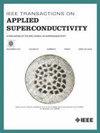A Finite Element $a$-$h$-Formulation for the Reduced Order Hysteretic Magnetization Model for Composite Superconductors
IF 1.7
3区 物理与天体物理
Q3 ENGINEERING, ELECTRICAL & ELECTRONIC
引用次数: 0
Abstract
The simulation of transient effects in large-scale superconducting systems with the finite element method is computationally expensive. A Reduced Order Hysteretic Magnetization (ROHM) model has been recently proposed for the computation of the magnetization and loss of composite superconductors. It accounts for the interplay between hysteresis, eddy, and coupling effects, without a need to model the detailed current density distribution, leading to a substantial reduction of simulation time. The ROHM model naturally fits in finite element formulations written in terms of the magnetic field such as the用有限元法模拟大规模超导系统中的瞬态效应计算成本很高。最近提出了一种用于计算复合超导体磁化和损耗的降阶滞后磁化(ROHM)模型。该模型考虑了磁滞、涡流和耦合效应之间的相互作用,无需对详细的电流密度分布建模,从而大大缩短了模拟时间。ROHM 模型自然适合以磁场为单位的有限元公式,如 $h$-$\phi$- 或 $\phi$- 公式,但这些公式并不总是最佳选择。例如,在存在铁磁性材料的情况下,人们可能更喜欢用磁通密度来写公式。在这种情况下,我们在本文中引入了一种实现 ROHM 模型的混合 $a$-$h$ 公式。这种公式的主要优点是可以直接使用 ROHM 模型定义的构成关系,而无需反演。我们讨论了新公式与传统的$\phi$公式相比的计算效率,后者基于复合超导链模型。
本文章由计算机程序翻译,如有差异,请以英文原文为准。
求助全文
约1分钟内获得全文
求助全文
来源期刊

IEEE Transactions on Applied Superconductivity
工程技术-工程:电子与电气
CiteScore
3.50
自引率
33.30%
发文量
650
审稿时长
2.3 months
期刊介绍:
IEEE Transactions on Applied Superconductivity (TAS) contains articles on the applications of superconductivity and other relevant technology. Electronic applications include analog and digital circuits employing thin films and active devices such as Josephson junctions. Large scale applications include magnets for power applications such as motors and generators, for magnetic resonance, for accelerators, and cable applications such as power transmission.
 求助内容:
求助内容: 应助结果提醒方式:
应助结果提醒方式:


